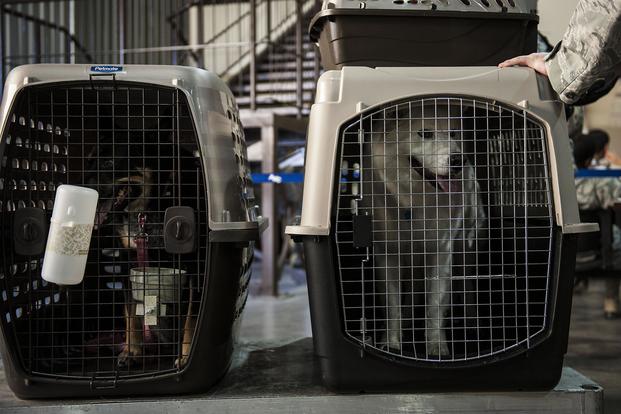If you have a dog, cat or other furry friend in the family, figuring out what to do with your pet when you have a permanent change of station (PCS) can be time-consuming and complicated. A move can also be considerably frightening for an animal.
Whether you're taking your pet with you or leaving it behind when you move to your next duty station, you need to start planning early. Having a family game plan for the changes ahead will help set your course.
Anticipate Costs of PCSing with Your Pet
While pet travel costs may be covered as part of your future PCS move thanks to a provision of the 2023 National Defense Authorization Act, be aware of the costs that could come up, depending on where you're going and how your pet will get there.
Some pet expenses to plan for:
- Health checks
- Vaccinations
- Quarantines
- Boarding fees
- Travel costs
Get Organized for a PCS with Your Pet
Not that long ago, when the calendar began to turn toward military moving season, families grabbed a three-ring binder and filled plastic sleeves with every piece of paper that might come in handy when moving.
Though you might still hand-carry paper files, these days we tend to gather essential records electronically and easily compile documents via apps or by saving important links.
Even if you choose to go paperless with electronic medical records, you'll still need to collect your pets' health history documents.
Vet Visit Before PCS
Make an appointment with your veterinarian as soon as you have a copy of your military orders. If you usually take your pet to the vet clinic on base, you'll notice that all the other pet owners will be getting ready for PCS season at the same time. It's a good idea to plan your appointment as early as possible.
If you're preparing for an overseas move, the vet on base will share a checklist to guide you through the steps you'll need to take.
Discuss with your vet whether your canine or feline should take anti-anxiety medication during travel. The use of a sedative can interrupt the natural process of how an animal regulates its own body temperature when handling stress, so you'll want to make sure your vet clears this option if it's needed.
This vet visit is also a good time to update necessary immunizations or renew prescription medicines.
Breed-Specific Legislation Within the US
If you'll be moving within the United States, take time to look up the regulations on breed and species requirements in your new area.
Breed-specific legislation, or BSL, prohibits ownership of certain breeds of dogs within a given municipality. Your service or base may have its own restrictions. Even if your duty station permits certain types of dogs, the municipality where it's located might not. In those circumstances, you could not legally take your pet off base. Know before you go.
Contact the state you're moving to so you can learn its pet importation rules. Make sure to have up-to-date vaccination and health papers.
Pet PCS Quarantines
If you'll be moving overseas, do a little research on the animal quarantine requirements. For example, dogs and cats will need specific blood tests, and getting those test results back can take a while. The earlier you begin this necessary process, the better it will be for the status of your pets and for your own stress level.
Within the U.S., Hawaii requires quarantine and an extensive list of vaccinations so that diseases are not imported to the islands. If you're moving to Hawaii, contact the Animal Quarantine Station for an information packet about the state's strict quarantine laws.
When moving overseas, check with the destination base, agriculture department and consulate of the destination country for specific health, transport and quarantine issues that may apply to your pet.
If traveling to Guam, Japan or Korea, pets are required to have all their documentation, paperwork and shots. There is a quarantine period as well.
OCONUS Moves with Your Pet
If you're moving overseas or outside the continental U.S. (OCONUS), things can be more complicated. Contact the consulate or embassy of the nation where you're moving to find out the specific regulations for bringing pets into the country. For international moves, most pets will need:
- An International Organization for Standardization (IOS)-compatible microchip (this can be read by most scanners).
- Proof of rabies vaccination with the microchip's number on it.
- A health certificate that's endorsed by your state's Department of Agriculture Animal and Plant Health Inspection Service office. If you can't physically get to the office, your veterinarian may have to send for the endorsement.
Some pets will also need:
- A Fluorescent Antibody Virus Neutralization (FAVN) blood test.
- An import form.
- Flea and tick preventative.
- Dewormer.
Additionally, MilitaryByOwner offers a complimentary Overseas PCS ebook with tips to ready your pets for an overseas adventure.
If You're Flying
Research airline instructions, prices and procedures for pets before you settle on one. Before you book, check to see whether airline veterinary employees work weekends. If they don't, book a weekday flight.
Pick a flight that's nonstop or has only one layover. Try to keep the entire trip to less than 12 hours.
Many pets have to ride in cargo holds that aren't temperature-regulated. Your pet will need an acclimation letter that specifies the temperatures that are safe for them.
Buy a crate that meets your airline's specifications, and give your pet time to get used to it. Have your name, your pet's name and your new address clearly marked on the crate, and have water bowls and food attached and accessible.
Verify that your pet is listed for the flight at the airport, and be sure to mention it to a crew member once you're on board, even though they're probably aware.
Pet Shipping
If you have to ship your pet, know the regulations.
These things are time-consuming, and your pet might be in quarantine for a while. It also might be costly, but there are opportunities for pet relocation financial assistance, and pets' transportation costs may be covered in the future thanks to a provision in the 2023 National Defense Authorization Act.
Microchip Your Pet
Whether making an overseas or stateside move, ensure that your pets are microchipped with your current contact information, and photograph and get an ID tag for your pet before you go. You may need to update this crucial info online. Current identification for your dog or cat can save the day if your pet wanders off in the flurry of moving day.
Make Pet Moving Day Plans
When your PCS plans are coming together and you're chatting with the representative at your pre-move assessment, clarify that your home includes animals. This will alert the moving company of potential pet dander allergens and the need for safety for your creatures.
Don't forget to add your pet's accessories to your "Do Not Pack" stash. Beyond their food and medicine, keep your critters' favorite toys or blankets with the items you plan to pack yourself. Setting aside a few familiar things can make the moving process seem less daunting for your pets.
While the packing crew is boxing up and loading all your worldly possessions, you may want to find a friend who will watch your pets or a drop-in pet day care. You'll likely want to arrange the same thing for when household goods are delivered at the new base.
Boarding Your Pet During a PCS
Friends and family are not always the best option to provide long-term care for your pet when you PCS.
Nonprofit deployment boarding organizations are usually not a long-term solution, either. As their names suggest, they assist primarily in deployment situations, as well as in cases of hardship or emergency.
However, some of these organizations offer short-term fostering for service members who PCS out of the country but whose pets are unable to travel at the same time due to weather conditions or quarantine. These foster arrangements can last up to six months.
Pets typically must be spayed or neutered and vaccinated prior to being accepted into foster care, and may require a microchip as well. Pets for Patriots partners with two nationally operating deployment boarding organizations, Dogs On Deployment and Guardian Angels for Soldier's Pet. Pact for Animals and Loving Paws Inc. are two more possibilities.
Re-Homing Your Pet Because of a PCS
The last option is the heartbreaking decision to re-home your pet. At times, this is the most responsible choice to make if you are unable to give your dog or cat a stable life.
But beware of the friend who will take your pet "off your hands," the elderly parent who feels obliged to take in your oversized dog, or the lure of online classifieds. Rarely do these offers end well for your pet.
If you just can't keep your pet and have to give it up, know it takes time to find a new home that's right. To prepare, go on one last veterinary trip for a checkup, vaccinations and to make sure they're spayed/neutered.
If you can't find anyone you know personally to care for your pet, advertise around your neighborhood or through a reputable online website such as Petfinder.
Be sure to screen candidates carefully to make sure they're a good fit and don't have malicious intent. Don't advertise that your animal is free; that's just asking for trouble.
Come up with important questions to ask potential adopters. Here are some good examples.
Be sure to share all your pet's behaviors, good or bad, including what they have problems with, whether they work well with kids and other pets, what their endearing qualities are, etc.
Contact rescue groups that can find a foster parent to take your pet. This way, you know your pet is going to be in good hands. If you have a purebred pet, or close to it, contact a breed rescue organization to see whether they'll foster it or let you post its adoption information on their website.
If those options don't work, research animal shelters thoroughly. Visit the kennels, meet the staff and familiarize yourself with their policies. Do they have a big play area for dogs to run? How often do pets get one-on-one time with people?
While no-kill shelters might sound like the best bet, consider whether your pet will be able to deal with the possibility of living their life in a cramped kennel.
If you feel uneasy about an adoption applicant or a shelter, go with your gut and make a different decision.
If your pet has bitten or nipped at someone, get a professional behavioral evaluation before giving the pet away. Also, check state and local laws about the liability that comes with giving a pet with a history of aggression away.
-- Amanda Miller can be reached at amanda.miller@military.com.















